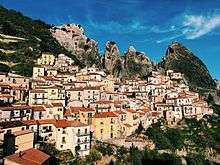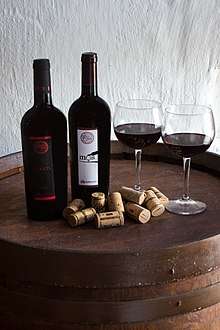Basilicata
Basilicata, also known as Lucania, is a region of Southern Italy.
Provinces
Basilicata is divided into two provinces:
| Matera (MT) The world-famous "sassi" of Matera, the suggestive landscapes of Murge plateau and "calanchi" (badlands), the Ionian coast rich of Greek archaeological remains and beach resorts. |
| Potenza (PZ) The green heart of the region with two National Parks, the pictoresque town of Maratea on the Tyrrhenian Sea, medieval villages and castles, excellent wines and products. |
Cities
- 🌍 Potenza — The regional capital and the largest city, home of Basilicata National Archaeological Museum
- 🌍 Irsina — One the oldest towns, rich of religious architecture
- 🌍 Maratea — The "pearl of the Tyrrhenian Sea" also known as "the town with 44 churches"
- 🌍 Matera — The town of "Sassi" (UNESCO World Heritage), declared European Capital of Culture for 2019
- 🌍 Melfi — Norman age center of the Vulture Area with the Castle of Emperor Frederick II
- 🌍 Policoro — Beach resort on the Ionian Sea, with a National Archaeological Museum
- 🌍 Venosa — One of "Italy's most beautiful villages", birthplace of Horace with an important archaeological site
Other destinations

- 🌍 Barile — Small village that preserves its Greek-Albanian origins
- 🌍 Craco — Fascinating ghost town, set of numerous films such as The Passion of The Christ
- 🌍 Lagopesole — Small medieval village located on a hill and dominated by the silhouette of a Norman castle
- 🌍 Metaponto — Resort on the Ionian Sea with the amazing remains of the Temple of Hera
- 🌍 Rapolla — Renowned center of winery production and spa
- 🌍 Senise — Beautiful and well preserved medieval town with an incredible variety of typical local dishes
Understand
Get in
By plane
Bari-Palese International Airport (BRI IATA) is 64 km distant from Matera and it is linked to the town by the regional bus company COTRAB. This airport is the best choice to reach the eastern-Ionian area of Basilicata, while Naples International Airport (NAP IATA) is the best option to exploring the western-Tyrrhenian area of the region. The Autolinee Liscio bus company provides linking from the Naples International Airport to the regional capital Potenza (170 km) in about two hours.
By train
It is possibile to reach Potenza from Rome in about 5 hours with one change at Salerno station, using the trains of the national operator. Ferrovie Appulo Lucane is a regional operator that provides connections from Potenza and Matera to Bari, but the travel can be quite long and sometimes uncomfortable since the efficiency of the service is far from excellent.
By car
Three autostrade (toll roads) can be used to reach Basilicata from other parts of Italy:



For more info you can check the site of Autostrade per l'Italia.
Get around
Strade statali (trunk roads) can be used for reaching internal destinations or the surrounding regions:
See
Archaeological sites
- Grumento Nova — Archeological park of the Roman city of Grumentum.
- Metaponto — Well preserved remains of the ancient Greek city of Metapontion.
- Rupestrian Churches of Matera — A high number of troglodyte churches excavated in the rock during the early Middle Ages (UNESCO World Heritage).
- Policoro — Remains of the Greek city of Herakleia.
- Venosa — Paleolithic park of Notarchirico, remains of the Roman city of Venusia and Jewish catacombs.
Castles
- Castle of Lagopesole in Avigliano.
- Castle of Cancellara
- Castle of Lavello
- Castello Tramontano in Matera.
- Castello del Malconsiglio in Miglionico.
- Castle of Muro Lucano
- Castle of Valsinni
- Aragonese Castle in Venosa.
Museums

- Exhibition venue of Palazzo De Lieto in Maratea
- Exhibition venue of Palazzo Ducale in Tricarico
- Museum-Workshop of the Peasant Culture in Matera.
- National Archaeological Museum of Alta Val d'Agri
- National Archaeological Museum of Basilicata "Dinu Adamesteanu" in Potenza.
- National Archaeological Museum "Domenico Ridola" in Matera
- National Archaeological Museum of Melfese "Massimo Pallottino"
- National Archaeological Museum of Metaponto
- National Archaeological Museum of Muro Lucano
- National Archaeological Museum of Siritide in Policoro.
- National Archaeological Museum of Venosa
- National Museum of medieval and modern art in Matera
Nature reserves
.jpg)
Approximately the 30% of Basilicata's total area is occupied by nature reserves. Here are the most relevant ones:
- Abetina di Laurenzana Regional reserve — Oasis rich of fauna such as the Italian wolf.
- Appennino Lucano-Val d'Agri-Lagonegrese National Park — 70.000 hectares of protected area in the heart of Apennines.
- Murgia Materana Regional Park — Characterized by the presence of rupestrian churches surrounded by the impervious territory of the Murge plateau (UNESCO World Heritage).
- Pantano di Pignola Lake — A WWF oasi near Potenza.
- Pollino National Park — With peaks that reach the heights of 2.260 meters, it is the largest national park of Italy and an UNESCO World Heritage site.
- Regional park of Gallipoli Cognato e Piccole Dolomiti Lucane
- San Giuliano Lake Regional reserve — A WWF oasis ideal for birdwatching.
- Volcanic Lakes of Monticchio Regional reserve — Two small likes situated under the Mount Vulture and surrounded by a dense forest.
Check for a detailed map of Basilicata's natural protected areas:
Villages

- Acerenza — Town of ancient Greek origins with a remarkable cathedral. One of Italy's most beautiful villages.
- Aliano — Surrounded by the striking landscape of "calanchi" (badlands), it is famous for having being the home of Carlo Levi during his exile in the fascist period.
- Castelmezzano and Pietrapertosa — Two of Italy's most beautiful villages, both located in the heart of Basilicata's Apennines.
- Guardia Perticara — Fascinating medieval town in the Val d'Agri territory, one of Italy's most beautiful villages.
- Rotondella — Known as the "Balcony of the Ionian Sea", it is perched on a hill with an amazing view over the Gulf of Taranto.
- Tricarico — One of the best preserved medieval historic centers of the region.
- Viggianello — Enchanting town surmounted by the massif of Pollino. One of Italy's most beautiful villages.
Do

- Take part in the Marriage of The Trees Festival in different parts of the region.
- Visit the Vulture region, the area of production of the world-famous DOC wine Aglianico del Vulture.
- Relax or take a bath in one of the resorts along the Ionic coast.
- If you are not afraid of heights try the incredible experience of "Volo dell'Angelo" (the Angel Flight): a flight between the towns of Castelmezzano and Pietrapertosa on a suspended steel cable. You will reach the speed of 120 km/h at 1020 meters of height!
Eat

- Fragola Cadonga — The "red gold of Basilicata", a variety of strawberry cultivated in the Metaponto plain
- Gnummareddi — Sheep or goat's offal rolled in bowels
- Pane di Matera (Matera Bread) — A typical bread prepared with durum wheat flour
- Peperone di Senise — Senise red pepper
- Sanguinaccio dolce — Creamy pudding made with dark chocolate
- Soppressata — Cured dry sausage typical of the whole Southern Italy
Drink

Stay safe
The region is one of the safest in the country. Pickpocketing and violent crimes are extremely rare.
Go next
- Apulia — It borders Basilicata to the east. You can explore the Alta Murgia National Park or the nearby cities of Bari and Taranto.
- Calabria — It borders Basilicata to the south. Visit the stunning beaches of Praia a Mare on the Tyrrhenian coast , or the Archaeological remains of the Greek colony of Sibari on the Ionic coast.
- Campania — It borders Basilicata to the west. The Cilento and Vallo di Diano National Park (UNESCO World Heritage) is quite close to Potenza and Maratea.